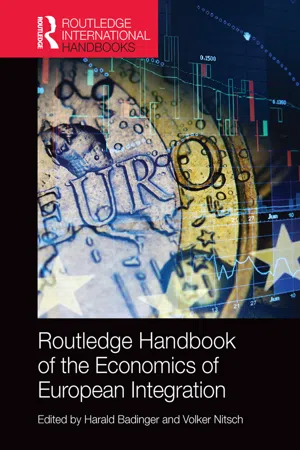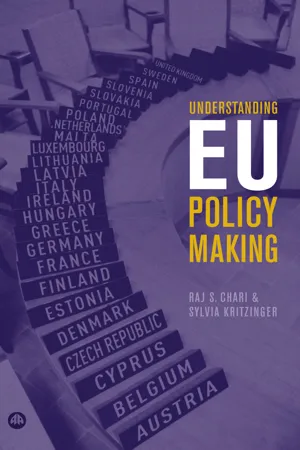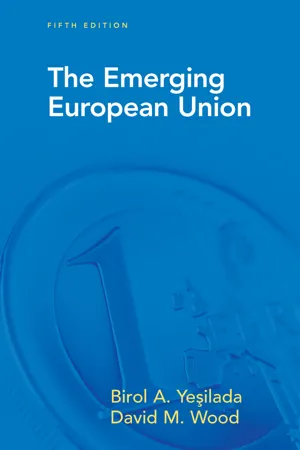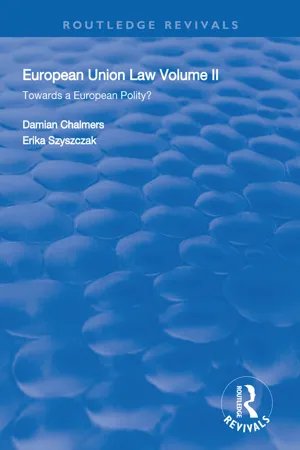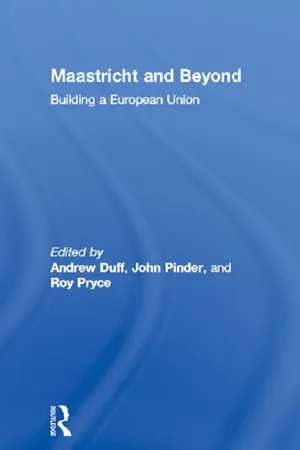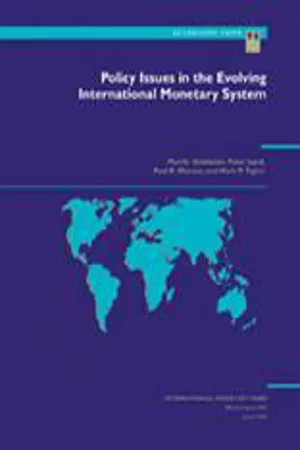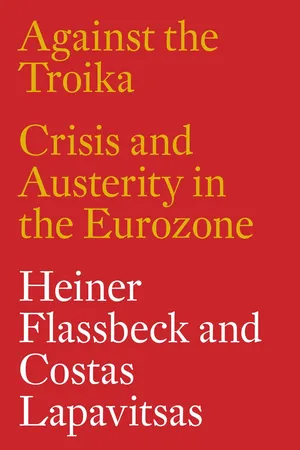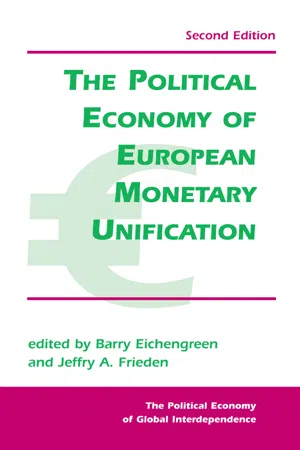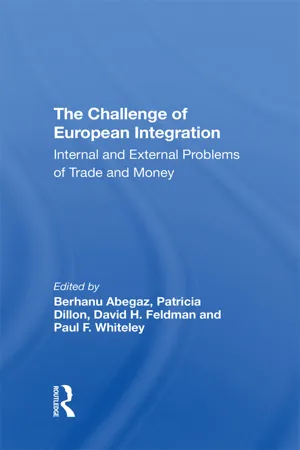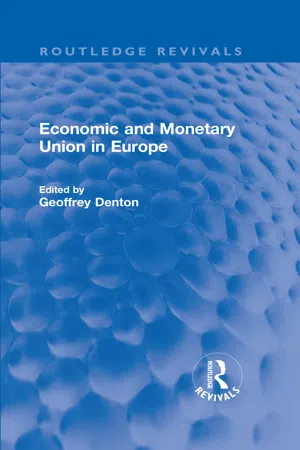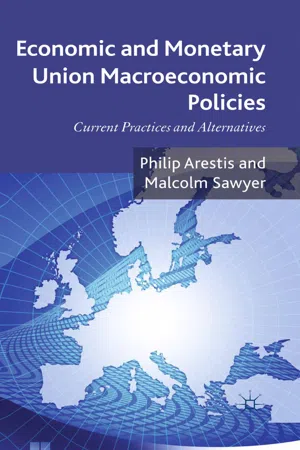Economics
Monetary Union
A monetary union is a group of countries that have agreed to share a common currency and coordinate their monetary policies. This typically involves a central bank that sets interest rates and manages the money supply for the entire union. The goal is to promote economic stability and facilitate trade and investment among member countries.
Written by Perlego with AI-assistance
Related key terms
12 Key excerpts on "Monetary Union"
- eBook - ePub
International Economic Integration
Limits and Prospects
- Miroslav Jovanovic(Author)
- 2006(Publication Date)
- Routledge(Publisher)
de facto EMU). This prevents any alterations in the rates of exchange as indirect methods of non-tariff protection or as a subsidy to exports. It also means that the member countries should seek recourse to the capital markets in order to find funds to cover their budget deficit. Within an EMU, it should be as easy, for example, for a Frenchman to pay a German within Europe, as it is for a Welshman to pay an Englishman within the United Kingdom (Meade, 1973, p. 162).A Monetary Union requires the following elements: • convertibility (at least internal) of the participating countries’ currencies; • centralization of monetary policy; • a single central bank or a system of central banks that control stabilization policies; • unified performance on the international financial markets; • capital market integration; • identical rates of inflation; • harmonization of fiscal systems; • replacement of balance-of-payments disequilibria with regional imbalances: • similar levels of economic development or a well-endowed fund for transfers of real resources to the less developed regions; and • continuous consultation about and coordination of economic policies among the participating countries, as well as the adjustment of wages on the union level.There may exist, also, a pseudo exchange rate union (Corden, 1972b). In this kind of union, member countries fix the exchange rates of their currencies and freely accept each others’ monies. However, since there is no pooling of foreign reserves and no central monetary authority, such a union is not stable. Since there is no mechanism to coordinate national policies, an individual member country may choose to absorb real resources from the union partners by running with them a balance-of-payments deficit. In addition, such a country may change the effective exchange rates of other members by creating a deficit in the union’s balance of payments with the rest of the world. A full EMU is not vulnerable to such instability. Foreign exchange rates are pooled and monetary policy is operated by a single monetary authority. In a pseudo exchange rate union, there is imperfect coordination of national monetary policies, but in a full EMU the problem is solved by policy centralization (Cobham, 1989, p. 204). - Harald Badinger, Volker Nitsch, Harald Badinger, Volker Nitsch(Authors)
- 2015(Publication Date)
- Routledge(Publisher)
2 The history of european economic and Monetary Union Harold James DOI: 10.4324/9781315796918-3 1 Introduction Europe’s move to monetary integration with a common currency (the euro) is a quite unique process, and is often held up as a model for monetary cooperation in other parts of the world: in the Gulf region, where there are periodic discussions of monetary unification, as well as in Asia and Latin America, where movements towards greater monetary integration also have some support but encounter a plethora of difficulties. Nevertheless, at the latest by the financial crisis of 2007–8, it became clear that there were substantial design flaws in the concept of the Economic and Monetary Union (EMU). As Patrick Honohan put it: “release 1.0 of the euro was under-designed, and robust only to moderate shocks.” (Honohan 2012) There has always been an ambiguity in the story of monetary integration: was it designed primarily to deal with a technical issue – alternatively formulated as exchange rate volatility as a barrier to trade and thus to greater economic integration, or else as a quest for price stability – or was it part of a grand political plan, in which money was used to tie the European knot? Jacques Rueff (1950), France’s major mid-century thinker about money, coined a phrase that was subsequently often erroneously linked to Jean Monnet: “L’Europe se fera par la monnaie ou ne se fera pas.” In the 1960s, a theory of optimum currency areas was developed by US-based economists (Mundell 1961, McKinnon 1963, Kenen 1969): although they continued to be influential figures in the European debate, their theories were irrelevant to the final push to monetary integration in the 1990s. The states that signed up to economic union had different expectations and hopes: some saw it as a way of building credibility and thus of reducing borrowing costs, while others focused on the constitutionalization of a stable monetary regime- eBook - ePub
- Raj S. Chari, Sylvia Kritzinger(Authors)
- 2006(Publication Date)
- Pluto Press(Publisher)
On the other hand, if the state wants to slow down the economy, it may pursue deflationary (or contractionary) monetary policies, increasing interest rates (so as to decrease inflation). With a single European currency area, however, member states would transfer this power to the “centre” and thus not have this ability to control their monetary policy. Padoa-Schioppa notes that “Monetary Union strictu sensu, is usually defined as the ‘irrevocable locking of exchange rates,’ the expression frequently used in the Delors’ Report, or the adoption of a single currency.” 1 But, Padoa-Schioppa also notes that the important feature of Monetary Union in the European case is that “the responsibility for monetary decisions is shifted to one single institution (namely the European Central Bank that is required to promote price stability) instead of being entrusted to a plurality of central banks. … In other words, creating Monetary Union means moving from a plurality of decision-making centres to just one” in order to increase the economic competitiveness of Europe on the world stage. 2 The 1989 Delors’ Report also insisted that fiscal discipline would need to be imposed on any state that formed part of Monetary Union - eBook - ePub
- Birol Yesilada, David Wood(Authors)
- 2015(Publication Date)
- Routledge(Publisher)
2 A common market involves establishing a customs union between two or more countries and free movement of all factors of production among the member states. The United States represents the most successful economic and Monetary Union.Europeans’ interest in EMU stemmed from their fear that continued revaluation of their national currencies vis-à-vis the dollar would threaten the stability of exchange rates, and thus of intra-EC trade, which had existed in the EC since 1957. The customs union and the maintenance of the common agricultural policy required stability; unstable exchange rates threatened the survival of the Community. Therefore, a drastic policy initiative was needed to achieve a zone of monetary stability among the EU member states.TRIAL AND ERROR IN EXCHANGE RATE POLICIES: THE ROAD TO EMS, 1971–1979
When the Bretton Woods system collapsed, the United States wanted the DM and the Japanese yen to be revalued against the dollar. This would have had the same effect on the U.S. trade deficit as an approximately 10 percent devaluation of the dollar; the difference would be that its impact would have been on those economies that contributed the most to the American trade deficit. The subsequent Smithsonian Agreement of 1971, where the industrialized democracies’ leaders attempted to coordinate their monetary policies, failed to bring stability to this situation. More crucial from the European point of view, this agreement and the subsequent reaction of the EC members to the collapse of Bretton Woods demonstrated how uncoordinated the European response was to the apparent crisis.In accord with the Smithsonian Agreement, the U.S. government devalued the dollar by 10 percent. Intra-EC trade faced immense obstacles from unstable prices due to exchange rate fluctuation. The EC responded to this pressure by establishing the snake in the tunnel and reduced the excursion allowed by the Smithsonian Agreement by half. The limit for fluctuations between EU currencies was to be only 4.5 percent. Before accession to EC membership, Britain, Ireland, and Denmark agreed to join the snake. The par value of each EC currency vis-à-vis the dollar represented the center of the tunnel. According to the agreed formulation, a variation of plus or minus 2.25 percent on either side of the dollar exchange rate determined the walls of the tunnel. Effectively, this arrangement established a joint float (snake) of the EC currencies that stayed within the walls of the tunnel formed by the maximum fluctuations around the dollar. - eBook - ePub
European Union Law
Volume II: Towards a European Polity?
- Damian Chalmers, Erika Szyszczak(Authors)
- 2018(Publication Date)
- Routledge(Publisher)
sine qua non for Monetary Union if mass unemployment is to be unavoided. For the latter can only be avoided by uncompetitive firms reducing labour costs or individuals moving from areas of labour surplus to areas of labour shortage. Yet this is also the language of 'sweatshop economics'. In social terms, its logic leads to people having to accept levels of wages and a degree of mobility and social dislocation which many would regard as unacceptable. It is doubtful whether such a scenario is socially acceptable or politically feasible. Federations deal with this problem through a system of inter-regional transfers of wealth from rich regions to poor regions, yet no comparable mechanism on such a scale exists within the Union. A rise in unemployment in some regions of the European Union is therefore highly likely as a result of economic and Monetary Union. Once again, however, this argument needs qualification. Such a development is also likely to happen from one State pegging its currency to another's. This has already happened within the context of the Exchange Rate Mechanism for a number of years. Monetary Union may, in this respect expand employment in the outer regions. For the central authority will no longer be the central bank of the base currency-in Europe's case the Deutschmark-but a European body which will be able to adopt a wider perspective and adopt a policy geared to European rather than to national interests.ii. The Route to Monetary Union
The TEU sets out a phased approach to economic and Monetary Union. In this it follows the structure of the earlier Delors Report which suggested a three stage approach to economic and Monetary Union.48 The first stage finished on 31 December 1993. By that date each Member State had to ensure free movement of capital unless granted a derogation by the Council.49 Member States also were required to adopt multiannual programmes intended to ensure the lasting convergence necessary for the achievement of economic and Monetary Union. These had to have regard to price stability and sound public finances. These reports also had to enable the Council to make an assessment on the progress made with regard to economic and Monetary Union and the progress on implementation of the internal market.50 - eBook - ePub
Maastricht and Beyond
Building a European Union
- Andrew Duff, John Pinder, Roy Pryce, Andrew Duff, John Pinder, Roy Pryce(Authors)
- 2002(Publication Date)
- Routledge(Publisher)
5 Fiscal and Monetary Policy in Economic and Monetary Union
Christopher Johnson DOI: 10.4324/9780203427125-5The two crises in the Exchange Rate Mechanism in September 1992 and August 1993 have led many people to think wrongly that the prospects for Economic and Monetary Union have become much more distant than when the Maastricht Treaty was signed. On the contrary, they have shown that premature exchange rate fixity, as well as being wrong in itself, was not the best or quickest road to full Monetary Union. They have also brought a number of benefits.Exchange rates have behaved quite stably within the new 15 per cent bands, in some cases returning de facto within the old 2.25 per cent bands. Realignments are off the agenda, because the wider bands allow more flexibility when it is needed. The speculators no longer have a one-way bet on offer, and the central banks are no longer involved in intervening to throw good money after bad, because they have refused to restore formally the old narrow bands. The new set of exchange rates is a better basis for fair competitive conditions within an eventual Emu than the old. Countries which have left the ERM or devalued have in most cases been able to lead recovery, thanks to lower interest rates and better export performance. In fact, the ERM crises have left Europe as a whole about 15 per cent more competitive against the USA, Japan and other major trading partners.The truth, moreover, is that neither economic nor Monetary Union has a clear and agreed definition. In the 1989 report of the Delors Committee, economic union is held to consist of four main components: the single market, competition policy, regional and structural policy, and macroeconomic policy coordination, including budgetary matters.1 All four go back to the Rome Treaty, enhanced by the Single European Act and then by the Maastricht Treaty. The most significant developments in economic union foreseen by the Maastricht Treaty are in the area of fiscal policy coordination. These are arguably less important and far reaching than the Treaty’s Monetary Union provisions, notably the establishment of a European Central Bank, with responsibility for a single monetary policy. Monetary Union can exist in a weak version, consisting of irrevocably fixed exchange rates, or a strong version, consisting of a single currency. The Treaty chose the strong version. An account of the Treaty’s provisions for Emu is given in Chapter Two - Mark Taylor, Peter Isard, Morris Goldstein, and Paul Masson(Authors)
- 1992(Publication Date)
- INTERNATIONAL MONETARY FUND(Publisher)
T his paper has focused on the value of exchange rate unions for particular groups of countries and on those characteristics that are likely to make a Monetary Union desirable and viable. The present situation facing industrial countries is one of high, and increasing, international financial integration; in those circumstances, some loss of monetary independence is inevitable. The fundamental question implied by membership in a currency union is whether the loss of monetary independence is likely to be more than compensated for by reductions in transactions costs and in exchange rate uncertainty, by superior inflation performance, and by the credibility added to the global purpose of economic and policy union. This question is currently most relevant to the EC, where moves toward currency union are part of a general trend toward greater economic and political integration. However, it is also relevant for other potential and existing currency unions, as well as for the entire membership of the IMF, as regional currency unions are likely to affect the functioning of the international monetary system.Passage contains an image
References
1Aizenman Joshua, and Jacob A. Frenkel “Optimal Wage Indexation, Foreign Exchange Intervention, and Monetary Policy ,” American Economic Review , Vol. 75 (June 1985), pp. 402–23.2Alexander William E., and Dale W. Henderson “Liberalization of Financial Markets and the Volatility of Exchange Rates ,” in Trade and Investment Relations Among the United States, Canada, and Japan ,ed. by Robert M. Stern (Chicago: University of Chicago Press, 1989), pp. 365–78.3Allen Polly Reynolds, Organization and Administration of a Monetary Union , Princeton Studies in International Finance, No. 38 (Princeton, New Jersey: International Finance Section, Department of Economics, Princeton University, 1976).4Argy Victor, “Choice of Exchange Rate Regime for a Smaller Economy: A Survey of Some Key Issues ,” in Choosing an Exchange Rate Regime: The Challenge for Smaller Industrial Countries ,ed. by Victor Argy and Paul De Grauwe (Washington: International Monetary Fund, 1990), pp. 6–81.5Argy Victor, and Paul De Grauwe “Introduction ,” in Choosing an Exchange Rate Regime: The Challenge for Smaller Industrial Countries- eBook - ePub
Against the Troika
Crisis and Austerity in the Eurozone
- Heiner Flassbeck, Costas Lapavitsas(Authors)
- 2015(Publication Date)
- Verso(Publisher)
One final point to mention is that command over world money is a measure of international political power which, in the case of the Euro and due to its creditor position, means primarily German power. It ought to be stressed that the EMU was not originally a plan to promote German ascendancy, but rather a formal, treaty-based alliance establishing rights and obligations for member states, and relying strongly on the ideology of Europeanism. Nonetheless, for reasons that are made clear below, the Euro has rebounded strongly in favour of Germany which – after the global financial crisis – has emerged as the country able to set economic and social policy across Europe as it is the main creditor. Yet, in view of the coming clash between debtors and creditors inside the Euro area, Germany’s pre-eminence remains extremely fragile.2. THE CORE MONETARY PRINCIPLES OF THE EMUA Monetary Union is first and foremost a union of countries willing to give up their own national currency for the purpose of creating a common currency. Giving up a national currency implies waiving the right of the national authorities to issue coins and notes and in this way to deploy national money (fiat money). Any decision with respect to issuing money would be delegated to a supranational institution. The decision-making organs of that institution would be designed to reflect the composition of the membership, but no single country would have a majority influence. National central banks still exist within the EMU, but the power to determine monetary policy and all related decisions has been transferred exclusively to the ECB and its Executive Board.Entering a Monetary Union also implies giving up national inflation targets and agreeing on a common inflation target for the union as a whole. The Deutsche Bundesbank, the anchor of the EMS and the role model for the ECB, had established monetarism, or the so-called Quantity Theory of Money, as the leading monetary doctrine in the years prior to the EMU. For a Monetary Union, monetarism would hold that the common central bank would be able to contain inflation across the entire union by steering the money supply and, moreover, that inflation differentials among the member countries would not occur. On this theoretical basis, the control exercised by the ECB over the money supply was deemed sufficient to hold the actual inflation rate of the EMU close to the target set by the ECB. - Barry Eichengreen(Author)
- 2018(Publication Date)
- Routledge(Publisher)
The implication for Europe is not a happy one. Insofar as these rigidities are both serious and slow to change, the costs of monetary unification may be considerable. A shock that raises unemployment in one EMU member state but does not elicit a reduction in interest rates by the ECB, because it does not produce comparable unemployment elsewhere in the Monetary Union, may give rise to a problem of a chronically depressed region. This suggests that the politics of EMU may be more compelling than the economics, or at least that the decision to go ahead needs to be understood on political as well as economic grounds.The Politics of Monetary Unification
A number of political factors are commonly adduced to help explain the course of European monetary integration. As a point of departure we distinguish interstate bargaining and domestic distribution.Interstate Bargaining
Even if Monetary Union does not enhance the welfare of all countries, it still may be in the interest of some, which then cajole, coerce, or bribe others into participating. This approach, generally associated with what political scientists refer to as "intergovernmentalism," interprets observed outcomes as the result of strategic interaction among national governments.11Most of those who utilize this approach have in mind a process in which governments trade off objectives -that is, they have in mind a form of "linkage politics." By linkage is meant the tying together of two (or more) otherwise unconnected issue areas, permitting the parties to an agreement to make concessions on one in return for concessions on the other(s). Thus, one country might "give" Monetary Union (which it does not favor inherently) in return for "getting" political union (which it does) if the perceived benefits of the latter exceed the costs of the former.12This approach, while appealing, is not unproblematic. For one thing, it is easy to fall into a vague invocation of a link among policy areas without paying careful attention to governments' preferences; for years, journalists and others invoked unspecified "geopolitical" motives to explain bargains among EU members. Any analysis that relies on implicit links must explain how it is we know that these links exist. While many commentators have argued that full participation in the Single Market might be hampered by nonparticipation in the EMS, for example, there is no provision in the Single European Act or any other EU document explicitly establishing this tie.- eBook - ePub
The Challenge Of European Integration
Internal And External Problems Of Trade And Money
- Jeffrey T Richelson, Berhanu Abegaz, Patricia Dillon, David H Feldman(Authors)
- 2019(Publication Date)
- Routledge(Publisher)
Economic and Monetary Union: The Economic Rationale and Design of the System . Brussels.____. 1990b. One Market, One Money . Brussels.Eichengreen, Barry. 1990. "One Money for Europe? Lessons from the U.S. Currency Union." Economic Policy April 1990: 118-187.Flood, Robert, Andrew Rose, and Donald Mathieson. 1991. "An Empirical Exploration of Exchange Rate Target Zones." Carnegie-Rochester Conference Series on Public Policy Autumn 1991.Folkerts-Landau, David. 1985. "The Changing Role of International Bank Lending in Development Finance." IMF Staff Papers . June 1985: 317-363.Frankel, Jeffrey. 1991. "Is There a Yen Bloc Forming in Pacific Asia?" unpublished manuscript, Institute for International Economics, Washington, D.C.Frankel, Jeffrey and Stephen Phillips. 1991. "The European Monetary System: Credible at Last?" NBER Working Paper No. 3819 .Frenkel, Jacob A., and Morris Goldstein. 1991. "Monetary Policy in an Emerging European Economic and Monetary Union." IMF Staff Papers . June 1991: 356-373.Frenkel, Jacob, Morris Goldstein, and Paul Masson. 1990. "The Rationale for, and Effects of International Economic Policy Coordination," in William Branson, Jacob A. Frenkel, and Morris Goldstein, eds., International Policy Coordination and Exchange Rate Fluctuations . Pp. 9-55. Chicago: NBER and University of Chicago Press.____ , ____, ____. 1991. "Macroeconomic Implications of Currency Zones," in Federal Reserve Bank of Kansas City, Policy Implications of Trade and Currency Zones .____, ____, ____. 1989a. "International Dimensions of Monetary Policy: Coordination versus Autonomy," in Federal Reserve Bank of Kansas City, Monetary Policy Issues in the 1990s . Pp. 183-232.____, ____, ____. 1989b. "Simulating the Effects of Some Simple Coordinated Versus Uncoordinated Policy Rules," in Ralph Bryant et al, Macroeconomic Policies in an Interdependent World . Pp. 202-259. Washington, D.C.: Brookings Institution.Goldstein, Morris. 1992. "Some New and Some Not-So-New Proposals for Improving the Policy Coordination Process." Paper presented at Banca d'Italia memorial conference in honor of Rinaldo Ossola on The International Monetary System, - eBook - ePub
- Geoffrey Denton, Geoffrey Denton(Authors)
- 2022(Publication Date)
- Routledge(Publisher)
2 Economic Management in a Monetary Union
Steven RobsonAt the Hague Summit in 1969, the Six agreed to create an economic and Monetary Union. The subsequent Werner Report became the blueprint for EMU, but was never embodied in a Council Resolution and therefore remains a background document. There are two EMU resolutions. The first of March 1971, followed the Werner Report in many respects. It stated that the aim was to turn the Community into an area “in which persons, goods, services and capital move freely and without distortions of competition, but without thereby giving rise to structural or regional imbalances, and under conditions enabling business to expand their activities on a Community scale’. At the same time the Community woul form a ‘separate monetary entity’ in the international monetary system.The principal features of EMU as described in the resolution are: complete and irreversible convertibility of currencies, elimination of margins of fluctuation and irrevocably fixed exchange rates; a Community organisation of Central Banks; transfer to the Community level of ‘the requisite decisions on economic policy’ and the power and responsibility ‘necessary for the cohesion of the union and the effectiveness of Community action’ in the fields of:- internal monetary and credit policies;
- monetary policy with the rest of the world;
- policies relating to the capital market and to movements of capital to and from the rest of the world;
- budgetary and fiscal policies (in particular the variation in ‘the essential elements’ of public budgets and the size, the use and the methods of financing of the budget balance);
- the regional and structural measures necessary to the balanced development of the Community.
The first stage in the process of forming the union was to last three years, finishing at the end of 1973, but the resolution was rather vague about its contents. It merely stated that these ‘should include’ a strengthening of the consultation procedures, particularly prior consultations, and the introduction of a system whereby the Council would lay down the broad outlines of economic policy at the Community level and also quantitative guidelines for the ‘essential elements’ of national budgets. Similar provisions were made for consultation and guidelines on monetary and credit policies. - eBook - ePub
Economic and Monetary Union Macroeconomic Policies
Current Practices and Alternatives
- P. Arestis, Kenneth A. Loparo(Authors)
- 2013(Publication Date)
- Palgrave Macmillan(Publisher)
4 Monetary Policy in the Economic and Monetary Union 4.1 IntroductionOur main focus of attention in this and the next chapter is on the EMU macroeconomic policy frameworks. We discuss monetary policy as implemented by the ECB in this chapter, and this is followed in chapter 5 by a discussion of the fiscal policy aspects of the Economic and Monetary Union (EMU). In this chapter we set out the specific elements of the monetary policy of the EMU, and consider the strengths and weaknesses of this policy as applied within the EMU.We examine in this chapter the institutional framework of monetary policy along with the strengths and weaknesses of the theoretical and empirical aspects of this policy. We begin by discussing monetary policy itself in section 4.2, and this is followed in section 4.3 by a discussion of inflation problems. In section 4.4 we discuss problems with economic activity; this is followed in section 4.5 by a discussion of the potential future of monetary policy developments. Finally in s ection 4.6 we offer a number of concluding remarks.4.2 Monetary policyWith the formation of the EMU, monetary policy has been removed from national authorities and from political authorities and placed with the ECB – that is, the ECB is not only supranational but also ‘independent’ of political (or other) authorities. The ECB and the national central banks are linked into the European System of Central Banks (ESCB) with a division of responsibility between them. The ECB has the responsibility for setting interest rates in pursuit of the inflation objective and the national central banks responsibility for regulatory matters.The ECB is set up to be independent of the European Union (EU) Council and Parliament and also of its member governments. There is, thus, a complete separation between the monetary authorities, in the form of the ECB, and the fiscal authorities, in the shape of the national governments comprising the EMU. It follows that there can be little coordination of monetary and fiscal policy. Indeed, any attempt at coordination would be extremely difficult to implement. For apart from the separation of the monetary and fiscal authorities, there is also the constitutional requirement that national governments (and hence the fiscal authorities) should not exert any influence on the ECB (and hence the monetary authorities). Any strict interpretation of that edict would rule out any attempt at coordination of monetary and fiscal policies. Nor is it desirable to co-ordinate fiscal and monetary policy in the view of the ECB:
Index pages curate the most relevant extracts from our library of academic textbooks. They’ve been created using an in-house natural language model (NLM), each adding context and meaning to key research topics.

